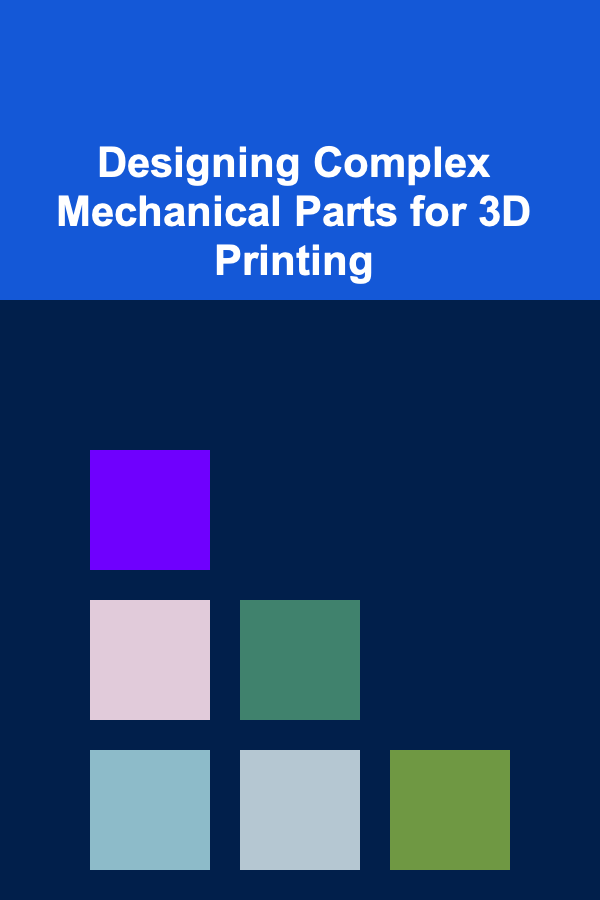
Designing Complex Mechanical Parts for 3D Printing
ebook include PDF & Audio bundle (Micro Guide)
$12.99$6.99
Limited Time Offer! Order within the next:

3D printing, also known as additive manufacturing, has revolutionized the prototyping and manufacturing landscape. Its ability to create intricate geometries and complex internal features allows for the production of mechanical parts that were previously impossible or prohibitively expensive to manufacture using traditional methods like machining, casting, or molding. However, designing complex mechanical parts for 3D printing requires a different mindset and a deep understanding of the technology's capabilities and limitations. This article delves into the key considerations, design principles, and best practices for designing intricate and functional mechanical components specifically tailored for 3D printing.
Understanding 3D Printing Processes and Materials
Before diving into design specifics, it's crucial to understand the common 3D printing processes and the materials they support. Each process has its own strengths and weaknesses, which significantly influence design choices.
Common 3D Printing Processes
- Fused Deposition Modeling (FDM): The most common and affordable 3D printing method. FDM extrudes molten plastic (typically thermoplastics like PLA, ABS, PETG) layer by layer. It's good for general prototyping and functional parts, but surface finish and accuracy can be limitations.
- Stereolithography (SLA): Uses a laser to cure liquid resin layer by layer. SLA produces parts with high resolution and smooth surfaces, making it suitable for intricate designs, detailed prototypes, and jewelry. Materials are generally more brittle than FDM plastics.
- Selective Laser Sintering (SLS): Uses a laser to sinter (fuse) powdered materials (typically nylon or other polymers). SLS allows for complex geometries and interlocking parts without support structures in many cases, making it ideal for functional prototypes and end-use parts.
- Selective Laser Melting (SLM) and Direct Metal Laser Sintering (DMLS): These are powder bed fusion processes similar to SLS but used for metals (e.g., aluminum, titanium, stainless steel). They produce strong, durable parts with complex geometries for aerospace, medical, and automotive applications. SLM melts the powder completely, while DMLS sinters it. The terms are often used interchangeably.
- Material Jetting: Deposits droplets of photopolymer material, which are then cured by UV light. This process allows for multi-material printing and supports a wide range of colors and textures. It's suitable for highly detailed prototypes and models with complex aesthetic requirements.
- Binder Jetting: Uses a liquid binder to selectively join powdered materials (metals, ceramics, sand). After printing, the part undergoes post-processing, such as sintering or infiltration, to improve its strength and density. Binder jetting can produce large parts relatively quickly and economically.
Material Considerations
The choice of material is critical and depends heavily on the application's requirements. Consider the following factors when selecting a material:
- Strength and Stiffness: The material's ability to withstand loads and resist deformation. Consider tensile strength, yield strength, and Young's modulus.
- Heat Resistance: The material's ability to maintain its properties at elevated temperatures. Important for parts that will be exposed to heat.
- Chemical Resistance: The material's resistance to degradation from exposure to chemicals. Consider the operating environment.
- Impact Resistance: The material's ability to withstand sudden impacts without breaking.
- Dimensional Accuracy: The material's tendency to shrink or warp during printing and post-processing. Critical for parts with tight tolerances.
- Cost: The material's price per unit volume or weight. Balance performance requirements with budget constraints.
- Surface Finish: The achievable surface roughness of the printed part. May require post-processing for smoother surfaces.
- Post-Processing Requirements: Some materials may require significant post-processing, such as support removal, sanding, painting, or infiltration.
Each printing process has a limited range of compatible materials. Refer to the 3D printer manufacturer's specifications and material datasheets for detailed information on material properties and printing parameters.
Design Principles for 3D Printing
Designing for 3D printing involves adhering to specific principles to ensure successful fabrication and optimal part performance. These principles often differ from those used in traditional manufacturing.
Orientation and Support Structures
Part orientation during printing significantly impacts build time, support structure requirements, surface finish, and strength. Optimizing the orientation can minimize material usage and improve part quality.
- Minimize Support Structures: Overhanging features require support structures to prevent them from collapsing during printing. Design parts to minimize overhangs or orient them to self-support. Consider using a 45-degree rule - features with angles less than 45 degrees to the horizontal typically require support.
- Strength Considerations: In FDM, parts are typically weaker along the layer lines. Orient parts to align the strongest axis with the direction of applied stress. For example, if a part will experience tensile loading, orient it so that the tensile force is perpendicular to the layer lines.
- Surface Finish: The downward-facing surfaces (those built on supports) usually have the worst surface finish. Orient parts to place less critical surfaces downwards.
- Build Time: Orient parts to minimize the build height, as build time is generally proportional to the number of layers.
When support structures are unavoidable, consider using soluble support materials (available for some FDM printers) that can be easily dissolved after printing.
Hollowing and Internal Lattices
Hollowing out parts and using internal lattice structures can significantly reduce material consumption, weight, and printing time without compromising structural integrity. This is particularly useful for large or complex parts.
- Hollowing: Create a hollow interior with a thin shell thickness (typically 1-3mm). Ensure adequate wall thickness to maintain structural integrity. Add escape holes to allow drainage of uncured resin (in SLA) or powder (in SLS) during post-processing. Carefully consider the location of the escape holes to minimize their impact on the part's function and aesthetics.
- Lattice Structures: Fill the hollow interior with a lattice structure. Common lattice types include cubic, diamond, gyroid, and tetrakaidecahedron. The choice of lattice type depends on the desired strength, stiffness, and weight reduction. Use software tools to optimize lattice parameters like cell size, strut thickness, and density.
- Consider Stress Concentrations: Sharp corners and abrupt changes in geometry can create stress concentrations, leading to failure under load. Use fillets and rounded edges to distribute stress more evenly. This is especially important when using hollow or lattice structures.
Features and Tolerances
3D printing has specific limitations regarding the minimum feature size and achievable tolerances. Design parts within these constraints to avoid printing failures and ensure proper functionality.
- Minimum Feature Size: Small features, such as thin walls or small holes, may not be printable due to limitations in material deposition and layer resolution. Consult the 3D printer manufacturer's specifications for the minimum feature size.
- Hole Diameter: Small holes may close up during printing. Design holes slightly larger than the desired size and use post-processing (e.g., drilling or reaming) to achieve the final dimensions. Orient holes vertically to improve accuracy and reduce the need for support structures.
- Tolerances: 3D printing tolerances are generally wider than those achievable with machining. Account for this in the design and consider using post-processing techniques to improve dimensional accuracy. Specify critical dimensions and tolerances on the design drawings.
- Threads: Printing threads can be challenging due to layer resolution and potential for overhangs. Consider using inserts or taps to create strong and accurate threads after printing. Alternatively, design threads with a larger pitch and thicker profile for improved printability.
- Moving Parts and Assemblies: 3D printing allows for the creation of interlocking parts and assemblies in a single print. Design clearances between moving parts to account for dimensional variations and potential friction. Use lubrication to reduce friction and improve the lifespan of moving parts.
Geometric Considerations
Certain geometric features are inherently challenging to 3D print. Understanding these limitations is crucial for designing successful parts.
- Overhangs: As mentioned earlier, excessive overhangs require support structures. Design parts with self-supporting geometries or split them into multiple parts that can be assembled after printing. Consider using a "bridging" technique, where a short span is printed without supports.
- Bridging: The ability to print a horizontal span between two supports. Design bridges with a slight arch to improve their strength and stability. Optimize printing parameters (e.g., print speed, temperature, and layer height) for successful bridging.
- Sharp Corners: Sharp corners can be stress concentrators and are difficult to print accurately. Use fillets and rounded edges to improve part strength and printability.
- Thin Walls: Thin walls can be fragile and prone to warping. Ensure that the wall thickness is sufficient to withstand the expected loads and handling during post-processing.
- Internal Channels: 3D printing can create complex internal channels for fluid flow or wiring. Design channels with a minimum diameter to prevent clogging and ensure proper flow. Consider the need for support structures inside the channels and design access holes for support removal.
Design Software and Tools
Several CAD software packages are specifically designed for 3D printing and offer features like topology optimization, lattice generation, and support structure generation. Some popular options include:
- Autodesk Fusion 360: A comprehensive CAD/CAM/CAE software with integrated tools for 3D printing.
- SolidWorks: A widely used CAD software with powerful design and simulation capabilities. Requires add-ins for advanced 3D printing features.
- Tinkercad: A free, browser-based CAD software suitable for beginners.
- Meshmixer: A free software for editing and repairing STL files. Useful for adding support structures and optimizing meshes.
- Netfabb: A powerful software for preparing models for 3D printing, including support generation, lattice design, and build optimization.
- Materialise Magics: Another comprehensive software for data preparation and build optimization for various 3D printing technologies.
These software packages allow designers to explore different design options, simulate part performance, and optimize designs for 3D printing.
Advanced Design Techniques
Beyond the basic design principles, several advanced techniques can further enhance the functionality and performance of 3D-printed mechanical parts.
Topology Optimization
Topology optimization is a computational method that optimizes the material distribution within a given design space to minimize weight and maximize stiffness under specific loading conditions. This technique can generate organic and complex shapes that are ideal for 3D printing.
- Define Design Space: Specify the volume within which the part can be designed.
- Define Constraints: Apply fixed constraints and loads to the design space.
- Set Objective Function: Define the objective to be minimized (e.g., weight) or maximized (e.g., stiffness).
- Run Optimization: The software iteratively removes material from the design space until the objective function is optimized.
- Smooth and Refine: The resulting geometry may be rough and require smoothing and refinement for manufacturability.
Topology optimization can result in significant weight savings and improved part performance, but it often requires specialized software and expertise.
Generative Design
Generative design takes topology optimization a step further by exploring multiple design options based on specified constraints and objectives. It uses artificial intelligence (AI) and machine learning (ML) algorithms to generate a range of design alternatives that meet the design requirements.
Generative design can help designers explore unconventional and innovative solutions that might not be apparent through traditional design methods.
Multi-Material Printing
Some 3D printing processes, such as material jetting, allow for the printing of parts with multiple materials in a single build. This opens up new possibilities for creating functional and aesthetically complex mechanical parts.
- Varying Material Properties: Use different materials to create parts with varying stiffness, flexibility, or hardness. For example, a compliant mechanism can be printed with a rigid material for the frame and a flexible material for the hinges.
- Color and Texture: Create parts with different colors and textures for aesthetic purposes or to differentiate functional areas.
- Embedded Electronics: Integrate conductive materials to create embedded circuits and sensors within the 3D-printed part.
Designing for multi-material printing requires careful consideration of material compatibility and interface adhesion.
Integrating Standard Components
Rather than printing an entire assembly, consider integrating standard components, such as bearings, fasteners, and electronic components, into the 3D-printed part. This can reduce printing time, improve part accuracy, and simplify assembly.
- Design Features for Integration: Create pockets or recesses in the 3D-printed part to accommodate the standard components.
- Consider Tolerances: Account for the tolerances of both the 3D-printed part and the standard components to ensure proper fit.
- Use Assembly Methods: Consider using adhesives, screws, or press fits to secure the standard components in place.
Post-Processing Techniques
Post-processing is an essential part of the 3D printing workflow. It involves various techniques to improve the part's surface finish, dimensional accuracy, and mechanical properties.
- Support Removal: Remove support structures using hand tools, pliers, or dissolving solutions (for soluble supports).
- Sanding and Polishing: Improve surface finish by sanding and polishing the part. Use different grit sandpaper to achieve the desired smoothness.
- Painting and Coating: Apply paint or coatings to improve the part's aesthetics, protect it from environmental factors, or enhance its mechanical properties.
- Machining: Machine critical features to improve dimensional accuracy and surface finish.
- Infiltration: Used for binder jetting to increase the density and strength of the part by infiltrating the porous structure with a metal or polymer.
- Heat Treatment: Apply heat treatment to improve the mechanical properties of metal parts.
The choice of post-processing techniques depends on the material, printing process, and desired part characteristics.
Case Studies and Examples
Numerous examples demonstrate the successful application of 3D printing for complex mechanical parts.
- Aerospace Components: 3D printing is used to produce lightweight and complex aerospace components, such as fuel nozzles, turbine blades, and structural brackets. These parts often incorporate topology optimization and lattice structures to minimize weight and maximize strength.
- Medical Implants: 3D printing allows for the creation of customized medical implants, such as hip replacements and dental implants, that are tailored to the patient's anatomy. The use of biocompatible materials ensures the implant's compatibility with the body.
- Automotive Parts: 3D printing is used to produce prototypes and low-volume production parts for the automotive industry, such as intake manifolds, brackets, and custom fixtures.
- Robotics Components: 3D printing allows for the rapid prototyping and customization of robotic components, such as grippers, linkages, and housings.
Conclusion
Designing complex mechanical parts for 3D printing requires a holistic approach that considers the capabilities and limitations of the technology. By understanding the different printing processes, materials, design principles, and post-processing techniques, designers can create intricate and functional parts that were previously impossible to manufacture. Embracing advanced design techniques like topology optimization and generative design, combined with a keen awareness of support structures, material properties and process limitations, unlocks the full potential of 3D printing for producing high-performance mechanical components. Continuous learning and experimentation are essential for staying abreast of the rapidly evolving field of 3D printing and pushing the boundaries of what is possible.

How to Evaluate Investment Risks and Rewards
Read More
How to Incorporate Soundproofing into Your Home's Interior Design
Read More
How to Safeguard Your Home from Seasonal Security Risks
Read More
How To Secure Funding for a Remote-First Company
Read More
How To Delegate Tasks Effectively
Read More
Embrace the Excess: A Deep Dive into Maximalist Fashion
Read MoreOther Products

How to Evaluate Investment Risks and Rewards
Read More
How to Incorporate Soundproofing into Your Home's Interior Design
Read More
How to Safeguard Your Home from Seasonal Security Risks
Read More
How To Secure Funding for a Remote-First Company
Read More
How To Delegate Tasks Effectively
Read More